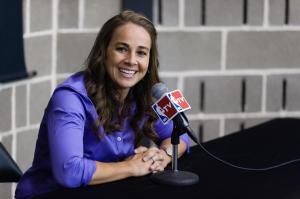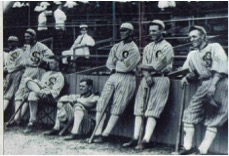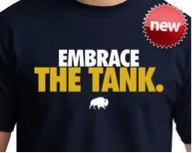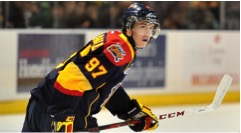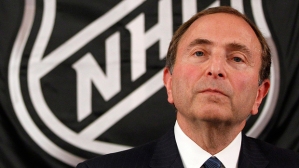Hockey needs fighting. I’m a die-hard hockey fan and I’ll be the first to admit that I enjoy seeing a fight during the game. That being said there is a time and place for fighting and there are also those who shouldn’t fight. Take for example Connor McDavid, Erie Otters forward and projected first overall pick in the upcoming 2015 NHL draft, got into a fight with Bryson Cianfrone from the Mississauga Steelheads and broke his hand when he punched the boards instead of his opponent. Many have argued that this is further proof that fighting should be banned, since a skill player like him is getting hurt, that it adds nothing to the game. First I think it’s important to note that fighting can be either classified as aggression or violence. Aggression as defined by Jim Parry as:
- “vigorous (trying to gain advantage by sheer force)
- offensive (in the sport context: battling for the ball)
- proactive (striking first)”
Whereas violence is “centrally to do with intentional hurt or injury to others, as well as attempts to harm, recklessness as to harm, and negligence.”
Now that we have dealt with the definitions we should think about why players fight. Fighting in hockey usually happens because two main reasons either to sway the moment in favour of your team, or for protection of fellow team mates or self. If we use Parry’s definitions in both cases the fighting would be aggression rather than violence for the players as they are not intentionally trying to hurt their opponent, in most fights there is a mutual agreement among the parties involved. What would be considered violence is slashing, cross-checking, and checking to the head all of which are more detrimental for the player who is on the receiving end; in these cases there is no mutual agreement between the players. In the OHL this week there has been 3 suspensions of 5 games or more for illegal hits, and only 1 suspension due to fighting all seasons. In fact this week the magazine The Hockey News surveyed 24 NHL members of various roles within the organization a number of questions regarding fighting, this was one of the more shocking results:
This is a shocking statistic that these 24 individuals believe that 58% feel players will be less safe if fighting were eradicated; most would have expected that the opposite would have been true. While they do not justify their choices I would have to think that it may have to do with the lack of reprimanding by players when their opponents make illegal hits on their team mates. This threat of repercussions of your acts keeps the players in check, it makes them think twice before committing the illegal hits. Earlier I mentioned the Connor McDavid fight and how many argued that he shouldn’t be fighting, I happen to agree with everyone. While each player has the right to defend themselves as a player, someone like McDavid who has only had 2 career fights, should not be fighting. There are others on their team who are more suited to do this for him, there are players who when need stand up for their team, it should not become the responsibility of the skill player to go out and fight. These players are typically called “enforcers” or “goons”. This of course is what many want to do away with; they believe that an unskilled player whose only job is to fight has no place in hockey. While that may have been true of enforcers and goons of the past, now a player must be able to pull their weight within a team and provide more than a threating presence.
What really needs to be dealt with is illegal hits. Here is a hit from this past weekend in the OHL:
http://www.ontariohockeyleague.com/video/index/id/ca7832ed3d5950adac8ae73cebba58d7
In this hit which Cole Cassels threw was dangerous and caused injury to the other player. These type of hits are far more common than fights, in fact these kinds of hit tend to cause fights. As I said earlier players look out for each other, they realize that these hits cannot be allowed, that they must hold each other accountable in case the referees and other officials do not. While there are rules against fighting, there seems to be an unwritten code in hockey that fighting has purpose within the game and player accountability, it should be the incidences where non-mutual violence occurs which we need to be consider with.
It also needs to be noted that we the fans have a lot to do with fights. I can vouch that when a fight breaks out the crowd erupts with a cheer and yells our advice to our player. This eruption of support gives him a rush of adrenaline to continue the fight and to fight in the future as he wants this gratification of the fans. Anyone who has been to a hockey game where a fight has broken out can vouch that you too get a rush out of watching the players fight, that it adds a sense of excitement for the fans as it does for the players. This video shows Michael McCarron, a forward for the London Knights, after a fight where he incites the fans to cheer louder as he comes off the ice, you can clearly see that not only he but the fans are on an adrenaline rush.
Even if you are against fighting in hockey it is clear that what we must be concerned with is player safety. What we the fans want is to watch a good hockey game played by these elite players and for it to be done safely. No fan enjoys seeing a player, regardless of which team they are on, get hurt.
Referenced Material:
McNamee, M. J., S. J. Parry, and MyiLibrary. Ethics and Sport. London ;; New York: E & FN Spon, 1998.
Further Readings and Videos:
Bobby Orr’s argument for fighting in hockey: http://www.theglobeandmail.com/sports/hockey/there-is-a-place-for-fighting-in-hockey-bobby-orr/article14850429/?page=all
Gary Bettman on fighting in the NHL: https://www.youtube.com/watch?v=5ahNkrD7C_k
Full Article on the survey of 24 NHL members on fighting: http://www.thehockeynews.com/blog/nhl-will-be-less-safe-if-figthing-disappears-say-hockey-insiders-thn-survey/
“Athlete Aggression on the Rink and Off the Ice.” By: Nick Pappas, Patrick McKenry, and Beth Catlett. Men and Masculinities 6.3 (2004): 291-312
“The Morality of Fighting in Ice Hockey: Should it be Banned?” By: Ryan Lewinson, and Oscar Palma. Journal of Sport & Social Issues 36.1 (2012): 106-12.
For More Hockey Fights and Statistics: http://www.hockeyfights.com/

